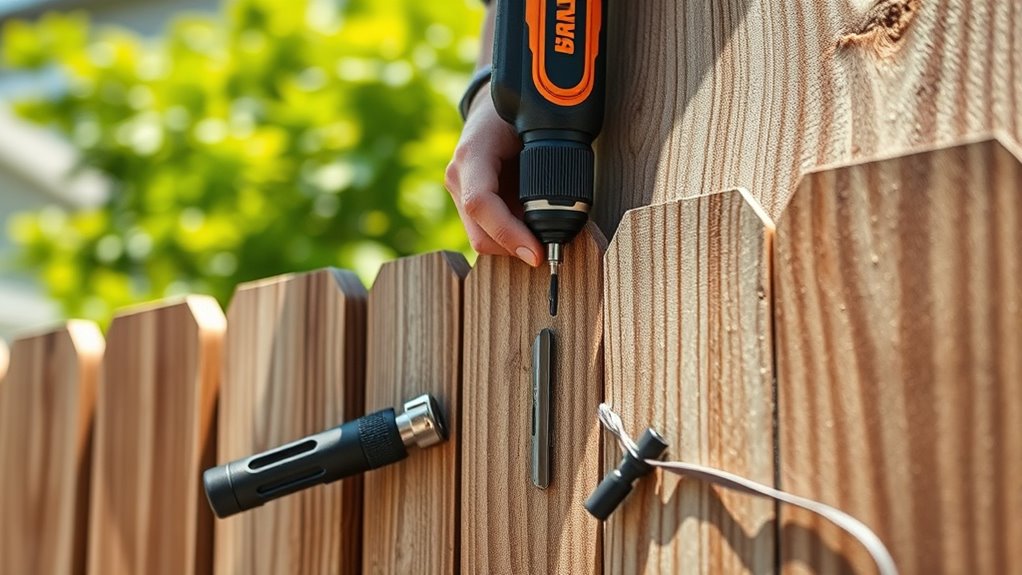To quickly fix your fence, choose low-maintenance materials like vinyl or chain link, which are easier to install and repair fast. Use essential tools such as a post driver and power drill, and opt for pre-fabricated sections or quick-set concrete to speed up the process. Focus on replacing damaged panels rather than rebuilding completely, and guarantee posts are level for lasting stability. Keep these tips in mind, and you’ll be back to secure fencing in no time.
Key Takeaways
- Use vinyl or chain link fencing for faster repairs due to easier handling and quick replacement options.
- Prepare tools like post drivers and pre-measured panels to streamline installation.
- Apply quick-set concrete to accelerate curing and stabilize new posts promptly.
- Focus on replacing only damaged sections with prefabricated panels for minimal work.
- Organize your workspace and gather all materials beforehand to avoid delays during repairs.

Need to fix your fence quickly? When time is tight and you need a reliable solution, understanding the basics of fence installation and material selection can make all the difference. Choosing the right materials and knowing how to install them efficiently can save you hours and get your fence back in shape faster. Whether your fence has a few broken panels or needs a complete overhaul, being prepared with the right knowledge ensures you won’t waste precious time searching for tools or making unnecessary trips to the store.
Start with material selection. The type of fencing material you choose directly impacts how quickly you can make repairs. For quick fixes, materials like vinyl or chain link are often more forgiving because they’re easier to work with and require less preparation. Vinyl fencing, for instance, is durable and doesn’t need painting or staining, so you can replace damaged sections without extra steps. Chain link fences are also straightforward to repair; often, all you need are replacement links or sections, which can be snapped into place swiftly. Wood fences, while popular, take longer to repair because they require precise measurements, cutting, and sometimes staining to match existing panels. So, if speed is your priority, stick with low-maintenance materials.
When it comes to fence installation for repairs, the key is efficiency. If you’re replacing entire panels or posts, ensure you have the right tools handy—such as a post driver or a power drill—and follow straightforward steps to speed up the process. Start by removing damaged sections carefully, then prepare the area by clearing debris or old concrete from the post holes. Using quick-set concrete mix can drastically cut down curing time, meaning your new fence sections will be sturdy and ready to go in a fraction of the usual time. When installing new posts, ensure they’re plumb and level, which prevents future issues and minimizes adjustments. Using pre-cut panels or sections can also save time—many suppliers offer ready-to-assemble fencing that can be installed with minimal fuss. Additionally, selecting durable fencing materials can reduce the frequency of repairs, saving you time in the long run.
If you’re pressed for time, consider pre-measured and pre-fabricated components designed for fast installation. These options often come with detailed instructions that streamline the process. Also, gather all your tools and materials before you start; this prevents unnecessary breaks and keeps your workflow smooth. Remember, the key to a quick-set fencing repair isn’t just about rushing through it but being organized and choosing the right materials for fast, effective installation. With proper planning, swift material selection, and efficient fencing techniques, you’ll have your fence fixed in no time, restoring both security and curb appeal without sacrificing quality.
Frequently Asked Questions
What Tools Are Essential for Quick-Set Fencing Repairs?
You need essential tools like a hammer, fencing pliers, and a post driver for quick-set fencing repairs. Start with proper fence post selection and choose repair material options suited to your fence type, such as wire, wood, or vinyl. Use the pliers to tighten and secure fencing, and the post driver to quickly install or replace posts. Having these tools on hand helps you make fast, effective repairs whenever needed.
How Long Does a Typical Quick-Set Fencing Repair Take?
A typical quick-set fencing repair takes about 30 minutes to an hour, depending on fence post stability and repair material selection. If your posts are loose, you’ll need extra time to secure or replace them. Using the right repair materials, like quick-setting concrete or sturdy brackets, speeds up the process. With efficient tools and proper prep, you can restore your fence swiftly and guarantee long-lasting stability.
Can Quick-Set Fencing Be Used for All Types of Fences?
Think of quick-set fencing as the Swiss Army knife of repairs—you might wonder if it fits all fences. While it excels for temporary fencing, offering swift fixes, it’s not designed for permanent fencing needs. You can use it to patch up chain-link or wooden fences temporarily, but for long-term solutions, permanent fencing is your go-to. It’s versatile for quick fixes but not a one-size-fits-all for every fence type.
Are There Safety Precautions for DIY Fencing Repairs?
Yes, there are safety precautions you should follow during DIY fencing repairs. Always wear safety gear like gloves, goggles, and sturdy boots to protect yourself from potential hazards. Be aware of your surroundings and check for sharp edges, loose wires, or unstable sections that could cause injury. Keep tools properly stored and handle them carefully. Staying alert and practicing hazard awareness guarantees your repair process is safe and efficient.
How Do Weather Conditions Affect Quick-Set Fencing Repairs?
Weather impact substantially affects quick-set fencing repairs. Rain, snow, or high humidity can delay curing times and weaken the repair, so you should avoid working in wet or freezing conditions. Seasonal considerations are essential; in colder months, wait for warmer weather to guarantee proper setting, while in summer, early mornings or late afternoons help prevent rapid drying or cracking. Always check weather forecasts before starting repairs for best results.
Conclusion
When a fence suddenly gives way, imagine yourself grabbing your tools and quickly patching the gap. With a few swift moves, you’re like a skilled artist restoring a broken canvas, turning chaos into order. The sun’s warmth on your back and the scent of fresh wood fill the air as you secure each piece. Before you know it, your fence stands tall again, ready to shield and define your space—proof that quick fixes can restore peace in a heartbeat.









